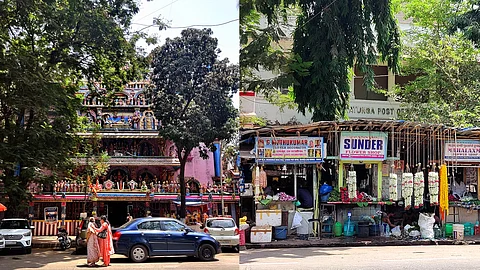
- HOMEGROWN WORLD
- #HGCREATORS
- #HGEXPLORE
- #HGVOICES
- #HGSHOP
- CAREERS
- ABOUT US
- CONTACT US

Every time I step into the bustling streets of Matunga, it's like embarking on a journey through time and memories. My feet inevitably lead me to Ramashray, a culinary haven where the divine aroma of Mysore masala dosa mingles with the delightful fragrance of filter coffee — not to forget their comforting pineapple kesari. The long queues at these eateries never faze me because the reward is always worth the wait. Every moment of waiting is rewarded with a taste of nostalgia and a sip of tradition. So, what is it about Matunga that holds a special place in the hearts of South Indians living in Mumbai?
To delve deeper, Matunga is more than just a neighbourhood; it is a gateway to my past that intertwines with my childhood and my mother's, seamlessly blending memories of family and tradition. It's a place where the charm of the '60s and '70s and vibrant hues of South Indian culture merge seamlessly with the energy of Mumbai's streets; a testament to the cultural fusion that defines this dynamic city.
Affectionately named the 'mini Madras,' Matunga is a treasure trove of South Indian heritage. For my mother, growing up here meant straddling two worlds — embracing the rhythms of Dakshin Bharat (South India) while being firmly planted in Paschim Bharat (West India). It was a unique blend, reminiscent of the Agraharam life of South India, an enclave beside a temple locality occupied by the Tambrahm community. It is deeply significant for South Indians as it's where our lineages ventured in search of prosperity. Those early migrants from the South to Bombay maintained a strong connection to their origins. Instead of abandoning their roots, they recreated elements of their ancestral land's environment in their new surroundings; fulfilling their affection for their homeland.
What sets this neighbourhood apart is, of course, its extensive culinary landscape, which can give you a taste of its cultural richness. Restaurants serve authentic delicacies that tantalise the taste buds, with flavours that transport you to the streets of Chennai. Dining on an ellai (a banana leaf) isn't just a culinary quirk; it's a tradition that adds an extra layer of authenticity.
However, the essence of Matunga lies not just in the food but also in its marketplaces and majestic temples. Adorned with vibrant garlands and fragrant blooms in some of Mumbai's oldest flower shops, the streets are a lively display of Matunga's rich cultural tapestry. Amidst the hustle and bustle, you can witness the graceful elegance of women in traditional sarees and the timeless charm of men in veshtis or dhotis, all of which adds an extra layer of authenticity to the neighbourhood. Strolling around will take you to scattered small shops specialising in regional spices, grains, and ground coffee. Little bookstores on the corner of the roads sell books in Tamil and Malayalam, where you will find pattis in cotton saris and long pottu (bindis) looking for their weekly zines.
Beyond these sights and aromas, it's the spirit of community that truly defines Matunga. During Margazhi Masam, an auspicious month in the Tamil calendar, the neighbourhood comes alive with the melodious strains of temple bells and the soul-stirring chants of group bhajans; infusing the air with a sense of reverence and devotion.
Frequently visiting Matunga while growing up was like living in a microcosm of South India within the bustling metropolis of Mumbai. It shaped my identity; instilling in me a deep appreciation for the rich tapestry of cultures that define our city. Here, the past and present coexist harmoniously; creating a mosaic of experiences that resonate deeply with anyone who calls this place home.
If you enjoyed reading this, here's more from Homegrown:
Kitschy Couture's 'Buttercream Fantasy' Collection Celebrates Diasporic Identity
Abhishek Sachidanandan's 'DHARMA' Captures The Essence Of Ladakh's Buddhist Heritage
From Ancient Rituals To Modern Identity: The Cultural Significance Of Piercings In India
